There are over one million people who have the words “thought leader” somewhere in their LinkedIn profile. When asked to name a thought leader, people will list anyone from Elon Musk to Andy Crestodina (who, by the way, collaborated with us on this research and strenuously denies any such allegations).
Thought leadership is talked about constantly, but rarely defined clearly. Do thought leaders need to be famous? Controversial? Experts in their field?
We partnered with Andy from Orbit Media and Michele Linn of Mantis Research to dig deeper into how professional marketers think about thought leadership, what determines its effectiveness, and why perceptions of it seem to be so fraught with contradictions.
In a 23-question survey fielded on SurveyMonkey Audience, we assessed the most common definitions of thought leadership and worked to unpack what separates the good from the bad.
Andy and Michele both wrote their own analyses of the thought leadership report. Andy’s includes additional data points and tips for how to capture the logos, ethos, and pathos of thought leadership (check out his writeup to understand more) and Michele’s article outlines her take on each finding, including why each point is interesting from a professional researcher’s perspective.
What is a thought leader?
Are thought leaders just those million people on LinkedIn? Are they charismatic geniuses like Albert Einstein or eccentric business leaders like Elon Musk? Are your college professors thought leaders?
Maybe it’s all of the above. Our respondents zeroed in on expertise in a specific subject area as the most important hallmark of a thought leader.
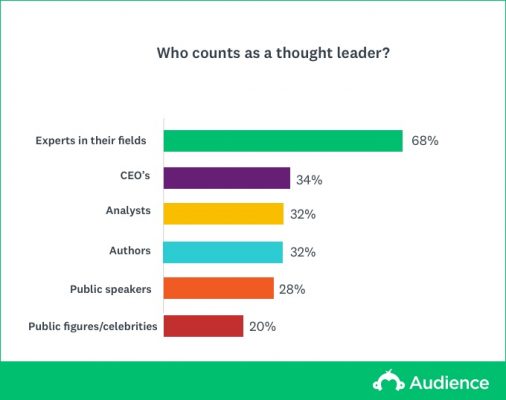
But beyond that, the definition was fairly fluid. Seventy percent of our respondents thought that brands are as capable of being thought leaders as individuals are, and a whopping 77% answered no to the question, “does a thought leader need to have a large social media following?”
More important than popularity was engagement. The marketers in our study didn’t think that you need to be an influencer to be a thought leader, but they did want you to be able to provoke a conversation.
What is thought leadership content?
Let’s start by talking about what thought leadership has to do. Many of our findings seem to boil down to one fundamental belief: thought leadership has to add value.
And while there’s a huge body of work outlining the virtues of thought leadership in marketing strategy, there’s also a not-so-secret assumption that a lot of “thought leadership” is, well, fluff. Are you saying something simply for the sake of saying something, or do you have actually have something valuable to say?
Here’s how author and speaker Michel Brenner talks about it:
“I have heard more than a few executives delay going all in on thought leadership by focusing on ‘the unique point of view.’ They say ‘there is so much noise in the marketplace. We can only compete if our content is differentiated and completely unique.’
I would argue that your audience isn’t looking for your content to be differentiated all of the time. They are just looking for the best answers to the questions.”
Our survey respondents seem to feel similarly. We asked them to rate the importance of different qualities of thought leaders, with the following results:
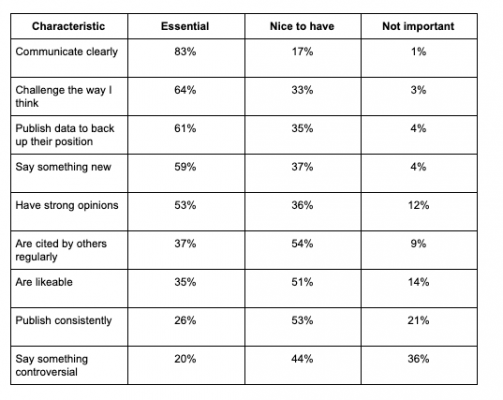
Marketers think that clear communication is by far the most important quality that thought leaders need, followed by challenging the way people think and publishing data to validate their opinions. The message is clear: It’s important to be visionary, but only if you can explain that vision in a way people can understand. It’s important to be challenging, but don’t be contrarian just for the sake of being different.
We also asked about whether thought leadership needs to motivate the reader to take action (70% said it’s very important) and whether educational content counts as thought leadership (71% said yes).
To sum up, thought leadership content doesn’t have to come from someone likable or high-profile, but it has to do at least one of the following:
- Be educational
- Drive action
- Leverage data
- Say something new
- Provoke discussion
But what about on a more tactical level? Here are the forms that thought leadership content can take, according to our respondents.
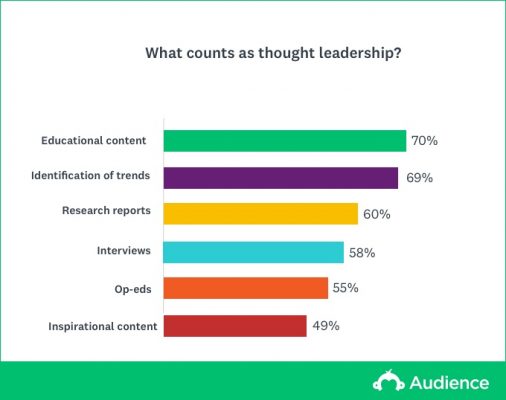
Why does thought leadership matter
Two-thirds of marketers (66%) consider thought leadership a “top priority” for their marketing org, but only 26% consider their current program “very successful” (though a healthy 65% say that it is moderately successful.)
Even with only moderate success, respondents saw a slew of different benefits from their thought leadership programs, both in terms of awareness building and lead generation.
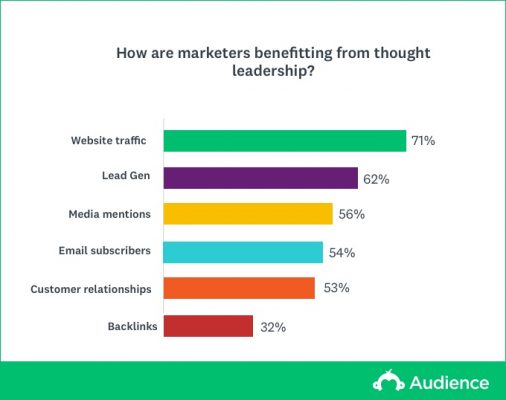
That’s a meaningful amount of traction, both in terms of revenue and brand perception—especially from a group that mostly rates itself as “moderately successful.”
But there’s also still a lot of opportunity to grow. According to a recent analysis of over 1 million Google searches, the number of backlinks a piece of content has may be the most important indicator of how well it will rank in search engine results. If only 26% of marketers are using thought leadership for backlinks, there’s a lot more potential.
Here’s a thought from SAP’s Kaan Turnali: thought leadership matters because stretching old ideas beyond their traditional boundaries creates new perspectives.
How to create thought leadership with substance
Whether or not you consider yourself a “thought leader”, the odds are that if you’re in marketing, you’re going to play some type of role in creating or promoting thought leadership.
If you want to give it that density that our respondents seemed to be craving, one of the most straightforward ways to do so is by doing original research. As a reminder, only 3% of our respondents thought that publishing data to validate a position wasn’t important—making it the most universally endorsed thought leadership characteristic in our study.
Note: for an end-to-end content marketing strategy based on surveys, check out the ultimate guide to using surveys for content marketing.
Start by finding your thought leadership goal, and work backwards
Lead generation thought leadership is different from thought leadership you use to build awareness through PR, content marketing, or social. Both types need to be relevant to your brand and business, but things that you create for lead generation need to be more closely aligned with your product’s value proposition—after all, you want to have a reasonable belief that they’re valid potential customers.
For PR thought leadership, on the other hand, you’re better served by not being overly product-centric. The media isn’t usually interested in being free advertising for your brand or agenda. What it is interested in is a unique point of view, with compelling evidence to back that viewpoint up. You want to make your opinion worthy of being news.
Spend some time thinking about the message you want to send and doing some background research to make sure that it’s really contributing to the conversation. 88% of our survey respondents think that good thought leadership must advance business goals, so you’ll need to find a topic that does that for your brand…and is challenging or interesting…and establishes credibility and legitimacy.
Across the board, your thought leadership will resonate better with data. Statistics can help tell a story much more succinctly and effectively than almost any sentence. As an example, consider these points from some of our previous research:
- 82% of people would rather read an article based on data than the author’s opinion
- 72% think data-based research is more persuasive than an op-ed
- 73% found it more trustworthy
See? Compelling.
Choosing to do original research instead of relying on previously published stuff will make your thought leadership unique (and therefore, more valuable) and give you control over the findings that you’ll need in order to make your point. And surveys are probably the easiest way to create original research.
But you need to research it in a way that feels as scientific and unbiased as possible, and teaches your readers something unique and actionable. Here are some guidelines for how to do that.
Remember that survey data measures perceptions, not absolute truth
The most important rule for making a trustworthy statistic is knowing its limitations. If you end up with a bunch of stats that are biased or misrepresented, you risk alienating your audience with distrust. Survey data is best at identifying trends, so be mindful about making claims that are too specific.
Here are some things that might skew your data:
- People might say they feel one way, but privately believe something else.
- Just because someone says they have an opinion doesn’t mean they are going to act on it.
- Sometimes, results can be so close that predicting outcomes can go either way.
- People might claim to have an opinion for the sake of finishing the survey, but not actually feel strongly about it.
Even the best national pollsters get it wrong sometimes. Being cognizant of potentially skewed data doesn’t make your findings less meaningful, but it does mean that you’ll want to be especially careful to focus your research on beliefs and perceptions, and to frame them accordingly.
Here are some ways to establish that your data is trustworthy:
- Include your methodology whenever you publish your data. This should include the sample size you used, the way your distributed your survey, and the dates that you did your research. There is a big difference between research of 10 people and 1000 people, and between responses that come from your friends and family and responses from a consumer panel. Check out our methodology blurb at the bottom of this article for a real-life example.
- Acknowledge any limitations to your research. Survey research doesn’t always have to be perfect. In fact, it never is. But if you don’t address the elephant in the room, people might discount your research entirely. Explain the limitations, then explain why your findings are striking in spite of them.
- Combine your findings with other published research. You don’t want to be reiterating points that have already been made, and you want to keep the spotlight largely on your own research, but you can use 3rd-party sources to add another lens to your research.
- Perceptions and trends tell powerful stories. That’s what makes survey research perfect for thought leadership. The way people think today speaks volumes about the way the world will look tomorrow.
DNA of a good thought leadership survey: how to structure a survey for good research
When most people start out with original research, they tend to default to random, disjointed questions designed to “explore a topic”, without any real cohesion. That may work if you’re trying to drum up some fun facts for social media, but for powerful thought leadership, you need focus.
It’s best to come up with a few key theses and then work back from there. To be clear, this doesn’t mean that you have a hypothesis and you’re just trying to force the data to prove it. It means that you are zeroing in on a few focal areas and getting hard data points to address each area. For our thought leadership research, we focused on how marketers define thought leadership, whom they consider thought leaders, and how they use thought leadership themselves.
Here’s a diagram that shows how you should divvy up your survey.
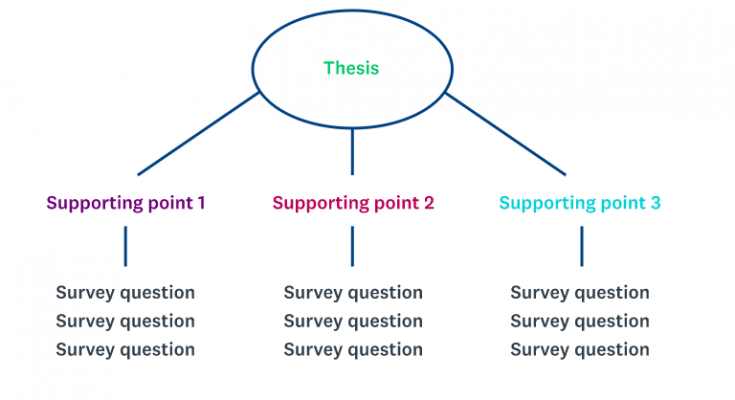
Now let’s get even more tactical: here are the question types that you can use for original research.
- Likert scale questions: Likert questions (questions that follow a scale like “strongly agree” to “strongly disagree”) follow a predictable pattern that most people are familiar with, even if they don’t take a lot of surveys. They allow respondents to reply based purely on sentiment toward the prompt, rather than carefully considering each answer option to decide which is best.
- Multiple choice questions: Standard multiple choice questions make up the bulk of your survey. They’re quick and easy to answer, and give you some nice punchy stats. Try to limit your options to 5 or less to keep your survey manageable.
- Multiple response questions: Any time that we asked our respondents to “select all that apply” in our thought leadership research—like the question about who can be a thought leader—we were asking multiple response questions. These types of questions are awesome for consolidating a whole ton of information into a single question and great for providing comparisons. They also don’t force respondents to choose a single answer, so might be more accurate. That said, they do require a little more time for respondents to do and don’t result in super polarized final results, which could make for fewer dramatic differences, if that’s what you’re going for.
- Open-ended questions:Open-ended questions force your respondents to come up with their own answers and type them in, so they take a little longer to do. Remember that more than 30% of respondents are on mobile devices, so they’ll be typing in their responses on a tiny screen! It’s best not to include any more than two open-ended questions to your survey, but they can also give you some incredible insights and quotable anecdotes. They’re the only place in your survey that your respondents can say whatever they like, so you can get interesting and surprising answers.
Types of thought leadership you can create from original survey research
When you’re done with your original research, you don’t need to publish all the findings at once. In fact, you may want to reserve some data for future thought leadership. A common best practice is to publish one major report with all the findings, supported by multiple blog posts or other pieces of content that link back to the main guide.
You can use original research for almost any of types of thought content that we talked about with our survey respondents:
- Blog posts, Medium, and LinkedIn: Incorporate a few key points or insights from your data into the quintessential piece of thought leadership content—the Medium post (or any other blog post.
- Reports: 60% of the marketers in the thought leadership study considered research reports to be thought leadership (which means that we, SurveyMonkey, are a thought leader! Whee!). Reports are the most common way to share large quantities of data. You can gate them for lead generation, or keep them open to use them to drive website traffic and backlinks.
- Press push: Some organizations also use research to generate press coverage. This usually involves some media pitching, a press release, and a blog post or report where the data is collected in one place. Many publications also accept contributed content, so op-eds and other articles are also options. This is a great chance to garner backlinks to a blog post or ungated report on your website—which, you’ll remember, happen to be the thought leadership area with the most untapped potential.
- Social media: Grab a stat or two and create images to post on various platforms. You can even create a full infographic, if you have the design resources.
- Speaking engagements: Speaking opportunities at conferences and other events are competitive. Fresh data is a good way to set yourself apart and make a more compelling case for your point. Embed dashboards or data points into your presentation for a memorable, visibly striking speaking experience (SurveyMonkey offers several ways to do this).
Whatever thought leadership is to you, it indisputably plays a role in most organizations’ marketing strategies. The more weight you can give your thoughts with data and actionable advice, the more inclined people will be to follow the lead.
Methodology: SurveyMonkey, Orbit Media, and Mantis Research surveyed 481 marketers to understand their attitudes about thought leadership. The results in this report are from an online survey that was fielded using SurveyMonkey Audience and organic outreach in February, 2020.
Want your own market research in minutes?
SurveyMonkey Audience gives you access to a panel of consumers from every age, background, and region.



